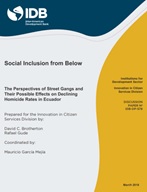Social Inclusion from Below: The Perspectives of Street Gangs and Their Possible Effects on Declining Homicide Rates in Ecuador
Date
Apr 2018
Since 2007, the Ecuadorian approach to crime control has emphasized efforts to reach higher levels of social control based on policies of social inclusion and innovations in criminal justice and police reform. One innovative aspect of this approach was the decision to legalize a number of street gangs in 2007. The government claims the success of these policies can be seen in homicide rates that have fallen from 15.35 per 100,000 in 2011 to 5 per 100,000 in 2017. However, little is understood about the factors and their combination that have produced this outcome. To explore this phenomenon, we developed a research project focusing on the impact of street gangs involved in processes of social inclusion on violence reduction. From April to October 2017, we collected multiple data sets including 60 face-to-face interviews with members from four different street subcultures in several field sites, field observations and archival materials to answer two primary questions: How has the relationship between street groups and state agencies changed in the past 10 years? How has this changed relationship contributed to a hitherto unexamined role in the homicide reduction phenomenon of Ecuador? We found that legalization helped reduce violence and criminality drastically while providing a space, both culturally and legally, to transform the social capital of the gang into effective vehicles of behavioral change. In policy terms, we argue that the social inclusion approach to street gangs should be continued and highlighted as a model of best practices of the state.



